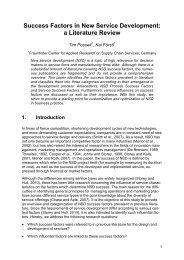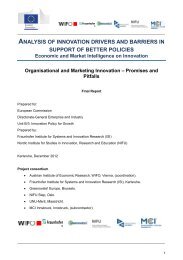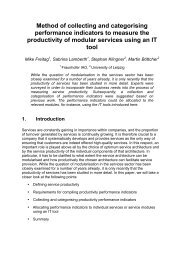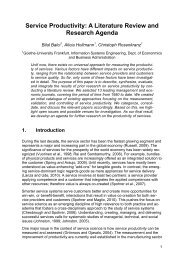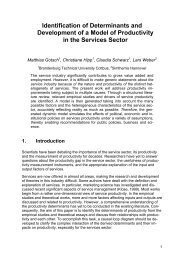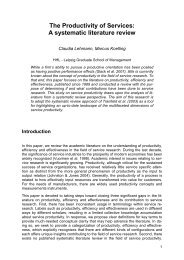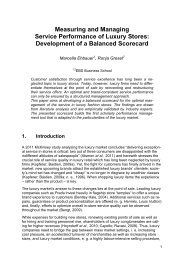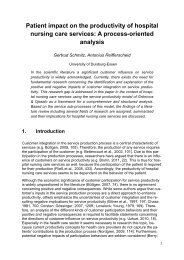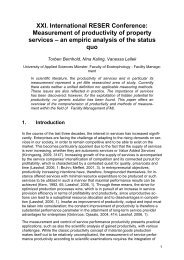More than sun, beach and heritage: innovating ... - RESER
More than sun, beach and heritage: innovating ... - RESER
More than sun, beach and heritage: innovating ... - RESER
Create successful ePaper yourself
Turn your PDF publications into a flip-book with our unique Google optimized e-Paper software.
<strong>More</strong> <strong>than</strong> <strong>sun</strong>, <strong>beach</strong> <strong>and</strong> <strong>heritage</strong>:<br />
<strong>innovating</strong> Mediterranean tourism through<br />
creative tourism. Interactions, co-operation,<br />
competitiveness <strong>and</strong> economic<br />
development.<br />
M. Teresa Fernández Fernández<br />
Rey Juan Carlos University (Madrid, Spain)<br />
Abstract<br />
This paper analyses the role of creative tourism as a source of competitiveness<br />
<strong>and</strong> locate its effects within the Mediterranean area. Creative tourism implies<br />
that both producers <strong>and</strong> consumers design <strong>and</strong> produce the service in<br />
interaction <strong>and</strong> that there is a knowledge transmission.<br />
Since creative tourism is a very recent activity, both dem<strong>and</strong> <strong>and</strong> supply<br />
features are studied showing that on the dem<strong>and</strong> side creative tourism comes<br />
to meet the highest human needs (socialization or self-actualization) <strong>and</strong> on the<br />
supply that it is subject to differentiation.<br />
In the last part of this work the state-of-art <strong>and</strong> impact of creative tourism in<br />
Mediterranean countries is studied, making some proposals to achieve it.<br />
1. Introduction<br />
Increasing competition between regions <strong>and</strong> cities for tourist resources is giving<br />
a more <strong>and</strong> more important role to creative tourism as an opportunity for<br />
development. This paper describes in a first part the concept <strong>and</strong> features of<br />
creative tourism <strong>and</strong> explains the main characteristics of its dem<strong>and</strong> <strong>and</strong> supply.<br />
The second part analyses creative tourism in Mediterranean countries. The<br />
regional focus has been chosen because Mediterranean countries have a big<br />
tradition in tourism, because they have a common history <strong>and</strong> identity, <strong>and</strong><br />
because tourism can be a key factor to promote competitiveness <strong>and</strong> contribute<br />
to the Euro-Mediterranean free-trade area.<br />
The paper starts with some of the recent <strong>and</strong> still scarce literature on creative<br />
tourism, trying to establish a concept which can differentiate it from other types<br />
of tourism. This definition can be broken out into different ways to approach the<br />
concept of creative tourism: as a service, as a concept suitable only for certain<br />
dem<strong>and</strong> according to personal motivations <strong>and</strong> needs, as a result of an<br />
evolution <strong>and</strong> as a production process which implies many activities interactions<br />
not only with those traditionally linked tourism.<br />
In section three an empirical analysis st<strong>and</strong>s out the main features of dem<strong>and</strong><br />
<strong>and</strong> supply. The dem<strong>and</strong> analysis is the result of a survey carried out by<br />
interviews <strong>and</strong> contains many interesting aspects about motivations, spending<br />
<strong>and</strong> factors conditioning creative tourism. The supply side analysis explains the<br />
market structure of creative tourism.
Section four is devoted to creative tourism in Mediterranean countries trying to<br />
know how this kind of tourism can contribute to the development <strong>and</strong><br />
competition of the Mediterranean area, thus building a common identity <strong>and</strong><br />
taking advantage of the tourism experience in the area, to the synergies trying<br />
to make traditional tourism resources more intangible. In this sense, the role of<br />
authorities in marketing cities <strong>and</strong> places <strong>and</strong> the use of new technologies is<br />
seen as very important to give knowledge <strong>and</strong> promote this kind of tourism.<br />
Some case studies are analised.<br />
2. Creative tourism: a multi-approach concept<br />
The concept of creative tourism is very recent <strong>and</strong> references are still scarce<br />
<strong>and</strong> not always coincide because it is a subject difficult to grasp, it is a product<br />
of innovation although to some extent it means travel more <strong>than</strong> tourism.<br />
Creative tourism is wide in activities, wide in motivations <strong>and</strong> moves between<br />
the frontiers of culture <strong>and</strong> experience.<br />
Since the adjective “creative” could relate to the Anglo-Saxon concept of<br />
“creative industries” first addressed in the 1990’s in United Kingdom when<br />
referring to arts, culture, design, music, film, <strong>and</strong> tourism; Power <strong>and</strong><br />
Gustafsson (2005) choose the concept “experience industries” intending “to<br />
shift focus away from the sort of producer perspective that usually dominates<br />
industrial policy to a consumer perspective that emphasises the importance in<br />
the knowledge economy of underst<strong>and</strong>ing consumer needs <strong>and</strong> preferences<br />
(KK-Stiftelsen, 2000 )”. Thus, tourism is included within experience industries in<br />
the Swedish sectoral classification (KK-Stieftelsen, 2003).<br />
The Creative Cities Network <strong>and</strong> UNESCO working group in their preparation<br />
for the first creative tourism conference say that creative tourism is “travel<br />
directed toward an engaged <strong>and</strong> authentic experience, with participative<br />
learning in the arts, <strong>heritage</strong>, or special character of a place, <strong>and</strong> it provides a<br />
connection with those who reside in this place <strong>and</strong> create this living culture<br />
(Creative Cities Network <strong>and</strong> UNESCO, 2006).<br />
Power <strong>and</strong> Scott (2004) say that the exact definition is not so relevant since<br />
“cultural”, “creative” or “experience” industries are concerned with the creation<br />
of products whose value rest primarily on their symbolic content which<br />
stimulates the experiential reaction of consumers in several ways.<br />
For this work <strong>and</strong> trying to be practical, the term creative tourism is near the<br />
definition of the Creative Cities Network <strong>and</strong> UNESCO working group, but<br />
emphasizing that what confers to creative tourism its identity is the close<br />
interaction between producers <strong>and</strong> consumers, who can interchange their roles,<br />
the sense of authenticity <strong>and</strong> symbolic charge or knowledge owned by a place<br />
<strong>and</strong> the transmission process of these knowledge, symbols or values which<br />
allow the tourist to acquire a new personal skill or capacity.<br />
The following approaches stem from the definition:
2.1 Creative tourism as a service where<br />
<br />
<br />
<br />
<br />
<br />
Both producer <strong>and</strong> consumer, can play sometimes each other’s role.<br />
That is the case for example of documented cases of tourist going to<br />
Namibia, who have learnt the local craftsmanship. These tourist have<br />
made their own artisan creations according to the local traditions <strong>and</strong> the<br />
local people have sold them in a process of mutual benefit: an intangible<br />
one for those who have acquired a new skill <strong>and</strong> a material one for the<br />
local tribes.<br />
There is a double intangibility due to interaction <strong>and</strong> feed-back <strong>and</strong><br />
participation of tourist which can add his values, experience, ways of<br />
behavior, etc., every creative service can be different<br />
Due to the use of new technologies this kind of tourism can be<br />
sometimes be delivered or consumed in the absence of physical contact<br />
between the two parts of the relationship <strong>and</strong> no simultaneity is needed<br />
between the two acts. For example, nowadays it is possible to visit<br />
museums through internet with computer applications that have been<br />
prepared in advance. The visit can be all the creative you want by<br />
choosing different itineraries or complementing it with other internet<br />
resources.<br />
It implies the transmission of knowledge or skills by the use of tangible<br />
creations but more importantly of intangible resources like experience,<br />
quotidian know-how or values.<br />
Creative tourism gathers a wide array of diversified activities according to<br />
the personal needs to satisfy. These sub-types of creative tourism are<br />
developed in interaction with other economic activities which can be the<br />
known as creative ones: music, theater, films or not, like gastronomy,<br />
agriculture <strong>and</strong> nature or manufacturing. In every economic activity there<br />
is a potential source for creative tourism. Both aspects are widely<br />
explained in the following subsections 2.2, 2.3. <strong>and</strong> 2.4<br />
2.2 An special kind of dem<strong>and</strong>: the creative tourism seeks for the<br />
satisfaction of the most elevated human needs<br />
Creative tourists, who should more appropriately be defined as travelers, search<br />
for the satisfaction of the most elevated human being’s needs more elevated<br />
needs according to Maslow’s hierarchy (Maslow, 1943) like love <strong>and</strong> belonging,<br />
esteem <strong>and</strong> self-actualization.<br />
2.3 Creative tourism as an evolutionary process leading to a post-modern<br />
way of production <strong>and</strong> consumption based on customization<br />
Richards, G. <strong>and</strong> Wilson, J. (2006) see creative tourism as “a solution to the<br />
serial reproduction of culture” as a result of “the rise of skilled consumption, the<br />
importance of identity formation <strong>and</strong> the acquisition of cultural capital in (post)<br />
modern society”. It is also more pronounced due to the globalization process<br />
which tends to homogenize tourism products <strong>and</strong> visitors’ behavior all around<br />
the world. These authors st<strong>and</strong> the challenge for places to convert physical<br />
<strong>heritage</strong> or cultural spectacles into more intangible resources where tourist are<br />
no longer passive consumers but active participants. Thus, creative tourism is<br />
the latest outcome of the evolution of the tourist activity. All changes are
supposed to modify things <strong>and</strong> add new things. However, creative tourism is the<br />
result of a backwards evolution, searching for the origins. In this process the<br />
tourist becomes a traveler as it happened in the beginning of the tourist activity<br />
searching for authenticity. As a result, creative tourism is no longer a serial<br />
tourism, but a tourism adapted to each particular situation that depends on<br />
producer <strong>and</strong> consumer (whether they play the two functions), the place, the<br />
moment <strong>and</strong> the tangible <strong>and</strong> intangible resources.<br />
Figure 1<br />
Evolution of the tourism production system<br />
First travelers Beach & Sun Tourism Cultural tourism Experience tourism Creative tourism<br />
Individual tourism Mass tourism Customised tourism<br />
Source: own elaboration<br />
This can be the result of a post-modern production system for tourism<br />
characterized according to Bell (1973) by the preeminence of professionals <strong>and</strong><br />
technical people with university studies as the core of the post-industrial society,<br />
as well as a change of values in the society in transition from an “economist<br />
model” to a “sociologist one” tending to a more humanistic society ab<strong>and</strong>oning<br />
the concept of people as machines. Therefore, tourism patterns are changing to<br />
more specialized activities where symbols, values, knowledge, experience <strong>and</strong><br />
traveler’s participation are very important.<br />
2.4 Creative tourism in relation with tourism <strong>and</strong> with other economic<br />
activities as source of development.<br />
Creative tourism not necessarily implies performing creative activities (Arts,<br />
Music, etc.) or shouldn’t only be provided by tourist agents. Since it implies that<br />
the tourist can acquire or develop skills only in that very concrete place or that<br />
he can live like this place people, it is interesting to know how economic<br />
activities can be linked to creative tourism to see how this kind of tourism can<br />
generate spillovers <strong>and</strong> economic development. Some of these interrelations<br />
can be featured in box 1, which has been built up according to the NACE codes.<br />
To set an example useful to distinguish creative tourism from different kinds of<br />
tourism we could take: theater (services, section R). Cultural tourism could<br />
consist of visiting a place <strong>and</strong> been told about its tradition in theater literature<br />
<strong>and</strong> theater festivals, experience tourism could be watching a theater<br />
performance in this city <strong>and</strong> creative tourism could be being taught to sew <strong>and</strong><br />
design the costumes for the theater performance in that city which in this case<br />
implies also a manufacturing activity from section C.
Box 1<br />
Interaction between creative tourism <strong>and</strong> the rest of economic activities<br />
PRIMARY SECTOR:<br />
NACE Sections A <strong>and</strong> B<br />
Creative tourists will learn to grow plants, farming, fishing or extract gold in rivers (for this last<br />
example, visit the Tankavaara village in Finl<strong>and</strong>): www. tankavaara. fi. Linked to rural tourism.<br />
SECONDARY SECTOR<br />
Section C: Manufacturing. Creative tourists can visit enterprises to learn about production<br />
processes. The more traditional <strong>and</strong> less complex are the more suitable they seem. For<br />
example: cheese making, manufacture of products of wood <strong>and</strong> paper, textiles <strong>and</strong> fur, printing,<br />
fabrication of perfumes <strong>and</strong> soap, tools, boats, jewelry, traditional musical instruments <strong>and</strong><br />
traditional games <strong>and</strong> toys. It would be linked to enterprise tourism<br />
Section D: Energy <strong>and</strong> water<br />
Courses on how to maximize the use of resources to minimize the environmental impacts<br />
Courses on traditional waste forms <strong>and</strong> composting. Linked to rural tourism.<br />
Section F: Building<br />
To participate in the reconstruction of a village. Linked to: rural tourism, cooperation tourism,<br />
enterprise tourism<br />
TERTIARY SECTOR: SERVICES<br />
Section G: Trade <strong>and</strong> vehicle reparation. For example: Selling fish in a Mediterranean village.<br />
Section H: Transport <strong>and</strong> postal activities. A real example could be how to manage a<br />
traditional means of transport: a donkey in Mijas, Málaga (Spain).<br />
Another example could be how to be an ancient Roman courier <strong>and</strong> discover Mediterranean<br />
cities<br />
Section I: Accomodation <strong>and</strong> food <strong>and</strong> beverage service activities<br />
Creative hostelling: as a real example in Marrakech there are some hotels who offer regional<br />
cooking courses<br />
Section J: Publishing activities, programming <strong>and</strong> broadcasting activities,<br />
telecommunications, computer programming <strong>and</strong> information service activities. Creative<br />
tourism activities publication, especially creative tourism itineraries using new technologies<br />
Section K: Financial <strong>and</strong> insurance activities. Example: insurance for creative tourism<br />
particularly adventure tourism<br />
Section L: Real Estate. Real Estate activities for creative tourism<br />
Section M: Professional, scientific <strong>and</strong> technical activities. Real example: how science<br />
allows to art creation using fractals, microscope images. Other examples: legal advice for nonconventional<br />
creative activities which could turn out to be illegal. The action of advertising<br />
creative tourism. Veterinary activities in horse-riding courses<br />
Section N: Administrative <strong>and</strong> support service activities.<br />
For example renting video-tapes to support creative activities, or searching qualified employees<br />
for creative tourism activities, or travel agencies specialized in creative tourism or l<strong>and</strong>scape<br />
activities<br />
Section O: Public Administration <strong>and</strong> defence; compulsory social security. For example:<br />
regulation of religious creative tourism by the Public Administration<br />
Section P: Education. Creative tourism is a good way to learn for students <strong>and</strong> as a<br />
complementary activity in Congresses<br />
Section Q: Human health <strong>and</strong> social work activities: Social workers help people to perform<br />
creative tourism activities for their social integration.<br />
Section R: Arts, entertainment <strong>and</strong> recreation. Creative tourism related to artistic performing<br />
activities. For some authors this should be the only <strong>and</strong> real section.<br />
Section S: Other services. Creative tourism as an activity of membership association<br />
Section T: Household employers. They should provide information on local traditions <strong>and</strong><br />
creative activities for the non-local house owner.<br />
Section U: Activities of extraterritorial organization <strong>and</strong> bodies. They can advise creative<br />
travelers about some aspects.<br />
Source: own elaboration<br />
To sum up, it can be said that creative tourism is a multidisciplinary activity both<br />
conceptually <strong>and</strong> practically which can be approached from Economics;
Environmental Sciences; History, Arts <strong>and</strong> Culture; Sociology, Anthropology<br />
<strong>and</strong> Psichology among others.<br />
3. DEMAND AND SUPPLY OF CREATIVE TOURISM: MAIN FEATURES<br />
3.1 Dem<strong>and</strong> of creative tourism<br />
Little research has been carried out about the features of the dem<strong>and</strong> side for<br />
creative tourism. For this work I have interviewed 28 people to establish their<br />
pattern of consumption of creative tourism. In a first moment I thought to go to<br />
the airport to make the survey but after that I considered that the difficulty of the<br />
concept could make that an stressful tourist could not underst<strong>and</strong> it. So I have<br />
taken varied people amongst my friends, relatives <strong>and</strong> workers in Spain or<br />
abroad of my personal surroundings. Except for three cases I haven’t sent them<br />
the survey but interviewed them, explaining carefully the concept of creative<br />
tourism. This way of obtaining the information is also interesting because it has<br />
allowed me to situate every person within his context, having thus an economic,<br />
cultural, anthropological <strong>and</strong> societal approach, which really has an influence in<br />
everyone’s perception of creative tourism. I consider <strong>and</strong> must say it, that by<br />
now, with the little development <strong>and</strong> recentness of creative tourism, this is the<br />
only way for obtaining information. They are men (53.4%) <strong>and</strong> women, from<br />
ages between 22 up to 70, with very different backgrounds <strong>and</strong> civil <strong>and</strong><br />
professional status, <strong>and</strong> some of them foreigners (39,3%).<br />
They have been asked about their past creative tourism experience <strong>and</strong> future<br />
desire <strong>and</strong> possibility for doing it (this last one in Mediterranean countries) <strong>and</strong><br />
about their motivations to practice this kind of tourism as well as their spending<br />
<strong>and</strong> time duration in a normal holiday <strong>and</strong> in a creative one.<br />
The creative tourism pattern is shown first in table 1:<br />
Table 1<br />
Creative tourism pattern of interviewed people (%)<br />
Desire to do creative tourism 85.7<br />
Desire <strong>and</strong> possibility of doing creative tourism 82.1<br />
Has had at least one creative tourism experience 78.6<br />
As a consumer 71.4<br />
of which it was<br />
an intended creative tourism activity 76.19<br />
creative tourism derived from other activity 71.4<br />
As a producer 46.4<br />
of which % were paid for it 30.8<br />
Source: own elaboration with interviews data<br />
As it can be seen, there is a big desire to do creative tourism (85.7%), though<br />
someone has it difficult due to work reasons. A great deal of the interviewed<br />
people has had a creative tourism experience. It is also interesting to say that<br />
as a consumer, 71.4% states that at least one of their creative experiences was
derived from another economic activity. These comments support what said in<br />
the previous section about the importance of interaction between creative<br />
tourism <strong>and</strong> other economic activities.<br />
It is significant as well that only 30.8% of the creative tourists taking the role of<br />
producers where paid. This indicates that informal economy is very present in<br />
creative tourism <strong>and</strong> I would like to set an example. Where I was one year old,<br />
we were spending our holidays in a little village on the East Mediterranean<br />
coast of Spain, near Alicante <strong>and</strong> Valencia. My father, a metal professional,<br />
decided to enjoy a fishing night on a fishers’ boat with the agreement of the<br />
fishermen where he could see, participate <strong>and</strong> underst<strong>and</strong> the Fishing Arts <strong>and</strong><br />
didn’t pay for it. This was 37 years ago. Yesterday, I have heard on TV that the<br />
Catalonian Fishermen Board is carrying out a pilot experience consisting of<br />
letting people to spend a journey on their ships knowing how to fish, <strong>and</strong> that it<br />
is done to complete the more <strong>and</strong> more reduced fishermen’s income. To<br />
promote <strong>and</strong> control this kind of activities can be a source of growth <strong>and</strong><br />
development.<br />
How can personal conditions influence the desire <strong>and</strong> possibility of doing<br />
creative tourism? To know it some correlations are worked <strong>and</strong> shown in table 2<br />
where it seems that only flexibility of time <strong>and</strong> personal motivation are behind<br />
the practice of creative tourism.<br />
Table 2<br />
Personal features <strong>and</strong> desire <strong>and</strong> possibility of doing creative tourism<br />
correlations<br />
With a time flexible work 0.806<br />
With a university degree 0.236<br />
Being non-Spaniard -0,007<br />
Being over 35 0.377<br />
Income 0.142<br />
Source: own elaboration with interviews data<br />
The cited reasons for doing <strong>and</strong> not doing creative tourism can be established<br />
in tables 3 <strong>and</strong> 4. Many motivations are related to the desire of knowing other<br />
ways of life, learning from them <strong>and</strong> interexchange with that people. This<br />
indicates that creative tourism motivations are related to the highest part of<br />
Maslow’s hierarchy of needs pyramid linked to socialization. It is also significant<br />
the number of reasons which see creative tourism coming up as a way of<br />
profiting for time <strong>and</strong> learning new things where working in a place which is not<br />
your actual home. Thus, we can see again the close interaction between<br />
creative tourism <strong>and</strong> other economic activities. It is also remarkable the<br />
reference to personal growth <strong>and</strong> personal enrichment linked to Maslow’s selfactualization<br />
needs fulfillment.<br />
Table 3<br />
Frequency of given reasons for doing creative tourism
To know other ways of life 13<br />
To learn for it 12<br />
For intercultural knowledge 7<br />
To analyse how they use their resources (economic context) 6<br />
To analyse their values <strong>and</strong> intangible things 4<br />
To underst<strong>and</strong> <strong>and</strong> analyse a social context 4<br />
To interexchange knowledge <strong>and</strong> values 4<br />
To transmit the learnt culture <strong>and</strong> values into my family or society 2<br />
To help people 1<br />
To be more integrated while working out of my city 5<br />
For personal growth <strong>and</strong> richness 4<br />
To do a non-planned <strong>and</strong> stressful vacation 4<br />
For a sense of uniqueness 4<br />
To acquire new creative skills 2<br />
For a change 1<br />
Source: own elaboration with interviews data<br />
It is remarkable to say that most of the reasons impeding the practice of<br />
creative tourism are related to work conditions or work time flexibility <strong>and</strong> to<br />
personal restrictive conditions, like for example having little children. These are<br />
also related to Maslow’s pyramid. We can say that only when the physical <strong>and</strong><br />
security needs are covered we can devote time to more creative forms of<br />
tourism.<br />
Table 4<br />
Frequency of given reasons for not doing creative tourism<br />
My work is very stressing <strong>and</strong> I want to rest 4<br />
I have an own business <strong>and</strong> it is very dem<strong>and</strong>ing 3<br />
Due to economic crisis it's cheaper another way of holiday 1<br />
It is not my use 1<br />
I have little children 1<br />
Source: own elaboration with interviews data<br />
What is different is the spending pattern which varies according to motivations,<br />
status <strong>and</strong> personal conditions. To compare I have taken as a reference the<br />
ordinary expenditure in Spain in a conventional holiday which is 90 Euros per<br />
day, according to official statistics, see IET). A classification of creative tourists<br />
can be set up according to profitability of creative tourism <strong>and</strong> is shown in table<br />
5. The first three categories make reference to people who pass or would be<br />
ready to pass all their free time travelling or in holidays in other places different<br />
from their homes <strong>and</strong> the rest categories contain people less prone to travel.<br />
Table 5
Holidays expenditure pattern according to the type of holiday carried out by<br />
creative tourists<br />
Prone to travel <strong>and</strong><br />
profitable<br />
Cat. 1 Cat. 2 Cat. 3<br />
Average days in a conventional holiday 9 20 15<br />
Average days in a creative holiday 23.3 10 15<br />
Average budget in a conventional holiday (eur) 766.7 2500 1425<br />
Average maximum budget in a creative holiday (eur) 1866.7 2500 2100<br />
Less prone to travel<br />
Profitable<br />
Cat. 4<br />
Nonprofitable<br />
Least prone<br />
to travel<br />
Nonprofitable<br />
Cat.<br />
5 Cat. 5 Cat. 6<br />
Average days in a conventional holiday 10 9 23 4 12<br />
Average days in a creative holiday 11 7 7 7 2<br />
Average budget in a conventional holiday (eur) 668 1500 1200 140 1250<br />
Average maximum budget in a creative holiday (eur) 990 2000 1340 350 275<br />
Source: own elaboration with the interviews data<br />
1. Category 1: really motivated for creative tourism with a constant<br />
travel budget. They spend one third or their holidays in a conventional<br />
vacation <strong>and</strong> would desire to spend the rest two thirds in creative<br />
tourism. People in their 30’s with stable works or non-family economic<br />
problems, two members of the couple work <strong>and</strong> pay by equal in their<br />
holidays. Prone to do-it-yourself experiences. People who in their<br />
conventional holidays spend on the average (around 90 euros) <strong>and</strong> the<br />
same in creative tourism by choosing non-expensive creative tourism<br />
holidays to enjoy more days. Travel with under age children or with<br />
friends.<br />
Profitability for creative tourism: though they are not big spenders they<br />
devote many days to the activity <strong>and</strong> travel accompanied.<br />
2. Category 2: retired or near retirement with great flexibility of time<br />
<strong>and</strong> big spenders in creative tourism. They spend two thirds of their<br />
holidays in a conventional vacation <strong>and</strong> would desire to spend the other<br />
third in creative tourism. With a conventional spending over the average,<br />
would be willing to pay twice the amount for having an authentic<br />
experience. They Travel with the rest of the family in their 30’s all of them<br />
with well-paid works. Profitability for creative tourism due to their big<br />
expenditure.<br />
3. Category 3: Non-migrant people without children with intercultural<br />
links by marriage or friendship. They would devote half of their<br />
holidays to intercultural creative tourism consisting of visiting couple’s<br />
family or friends. They really value the intercultural exchange for what<br />
they prefer to have a more reduced budget in their conventional holidays<br />
<strong>and</strong> spend more during their intercultural visits.<br />
4. Category 4: Non-married people with stable works. They would share<br />
less <strong>than</strong> half of their holidays both in conventional or creative tourism.<br />
Cat.<br />
7
Spending pattern under the average in conventional holidays <strong>and</strong> more<br />
expensive in creative ones.<br />
5. Category 5: married people travelling in couple or with the whole<br />
family. Average expenditure in a conventional holiday <strong>and</strong> more<br />
expensive in creative ones.<br />
6. Category 6: Inmigrants. They devote most of their holidays to visit their<br />
relatives. Since they live an intercultural day-to-day they would spend<br />
less for a creative tourism activity. Their conventional holidays are visits<br />
to the family<br />
7. Category 7: Students with little income. They cannot afford a long or<br />
expensive vacation<br />
8. Category 8: Weekend creative people. Little impact for creative<br />
tourism. Really devoted to arts or gastronomy<br />
3.2 Supply of creative tourism<br />
It is remarkable to see how the mass production system of tourism has lead to<br />
the creation of big hotels <strong>and</strong> travel agencies which have st<strong>and</strong>ardized the final<br />
product: our holidays. With the tourism st<strong>and</strong>ardization its market has turn out to<br />
be a perfect competition one, with similar products/service everywhere, that is<br />
to say, mass tourism has more to do with industrial markets <strong>than</strong> with services<br />
markets (those last ones more easily suitable to imperfect competition markets).<br />
And this is the real panorama when talking about tourism multinationals or big<br />
tourism enterprises which is the most prominent from the supply side.<br />
For this work I have analysed the web pages of some travel agencies <strong>and</strong><br />
tourism enterprises <strong>and</strong> have discovered that the biggest <strong>and</strong> important the<br />
travel agent is, the little possibility appears to find something different <strong>than</strong><br />
travel <strong>and</strong> hostelling (price, hotel category <strong>and</strong> number of days). There are only<br />
timid attempts to do something different related to experience tourism (for<br />
example Barceló agents in Spain, www.barcelo.es, developed some years ago<br />
a programme to hire travelers to tell their experiences in order to publish a<br />
magazine <strong>and</strong> show attractive different locations around the world). They<br />
developed the “smart boxes” which are defined as the perfect present for living<br />
a different break. In these boxes you can find an experience: horse-riding, spa,<br />
gastronomy. It is an attempt to improve <strong>and</strong> customize according to the type of<br />
consumer but in this innovative service there is little margin for the consumer for<br />
the interaction <strong>and</strong> the skills acquisition <strong>and</strong> the experience is carried out in a<br />
short times, normally week-ends. So, we must say that creative tourism is not<br />
present or has an insignificant role in big tourism enterprises.<br />
Creative tourism conforms however a differentiated market where small <strong>and</strong><br />
medium enterprises (SMEs) can compete. The most specialized or creative is<br />
the service, the biggest will be the opportunity for an SME. With creative<br />
tourism, it can be said, that tourism goes back to be a real service, with a great<br />
deal of intangibility.<br />
But it is not only a matter of enterprise size, the real thing is in the inputs. How<br />
traditional resources of tourism (<strong>heritage</strong> or nature) can be converted into
intangible resources or even when traditional resources are not present how a<br />
tourism value can be created. I have recently known from a village in Palencia,<br />
a lagging-behind region in Spain, where no one should desire to stop. They<br />
have devoted all many building facades for artist to go there <strong>and</strong> freely expose<br />
their works.<br />
It can be said that creative tourism it is most competitive when it can be<br />
described as a monopolistic competition market where all agents are implied in<br />
offering differentiated services full of authenticity <strong>and</strong> symbolic values linked to<br />
a particular place. A market where enterprises, authorities <strong>and</strong> customers<br />
interact, where every travel is different resulting from this interaction <strong>and</strong> agents’<br />
characteristics <strong>and</strong> where a knowledge transmission is present.<br />
4. CREATIVE TOURISM IN MEDITERRANEAN COUNTRIES<br />
The process of globalization <strong>and</strong> the European Union attempt for establishing a<br />
Euro-Mediterranean free-trade area is forcing countries to be competitive.<br />
Travel plays a positive role in most of these economies as it can be seen in<br />
table 6 <strong>and</strong> compensates the whole balance of payments.<br />
Table 6<br />
Balance of payments <strong>and</strong> travel balance in some Mediterranean countries<br />
(million EUR)<br />
Europe<br />
Balance of payment settlement<br />
Travel balance settlement<br />
Bulgaria -6304 955<br />
Cyprus -1832 885<br />
France -22320 12785<br />
Greece -32387 8833<br />
Italy -37361 11199<br />
Malta -347 449<br />
Romania -16715 51<br />
Slovenia -1455 980<br />
Spain -105894 27811<br />
North Africa & Middle East<br />
Algeria 22302 -115<br />
Egypt 292 805<br />
Israel 3304 -147<br />
Jordan Na 812<br />
Lebanon -1018 1708<br />
Morocco -51 4591<br />
Palestine Na -168<br />
Syria 334 1632<br />
Tunisia -679 1564<br />
Source: Eurostat (2009)
Why should creative tourism be promoted in Mediterranean countries?<br />
Richards, G. <strong>and</strong> Wilson, J. (2008) say that “cultural tourism is a “good” tourism<br />
because it attracts the right kinds of tourist who will appreciate the local culture<br />
<strong>and</strong> inject much needed money into the local economy thus promoting<br />
development”. This statement can be also applicable to creative tourism which<br />
can be a “good” form of tourism within the Mediterranean area for several<br />
reasons:<br />
<br />
<br />
<br />
<br />
<br />
<br />
<br />
It is (most of the times) environment friendly. This is especially important<br />
as a means to preserve the most deteriorated spaces in the<br />
Mediterranean which have suffered an oversized coastal expansion in<br />
other times <strong>and</strong> can also avoid this kind of expansion in those areas<br />
which have less tourist tradition.<br />
It preserves the physical <strong>and</strong> cultural <strong>heritage</strong> <strong>and</strong> contributes to increase<br />
it. Both producers <strong>and</strong> consumers maintain <strong>and</strong> spread, many times by<br />
word of mouth, the intangible <strong>heritage</strong>: values, symbols, skills in art or a<br />
particular atmosphere that can be destroyed with the homogenization of<br />
culture due to globalization. This should enhance the image <strong>and</strong> prestige<br />
of the area with a new air <strong>and</strong> reinforce its identity as a whole.<br />
Creative tourism, frequently (but not always) employ high-skill, creative<br />
workers <strong>and</strong> is carried out by people with certain knowledge or at least<br />
an interest to know. In less-advanced areas, like East Europe or North of<br />
Africa <strong>and</strong> the Middle East, the interexchange between the travelers <strong>and</strong><br />
the local people can contribute to knowledge transmission that can<br />
increase knowledge <strong>and</strong> culture of the inhabitants of those laggingbehind<br />
regions. This is an important externality.<br />
Creative tourism can contribute to the quality of life in the Mediterranean<br />
countries due to the services <strong>and</strong> inputs associated to them <strong>and</strong> to the<br />
generation of spillovers.<br />
It can contribute to avoid the loss of employment <strong>and</strong> provide with new<br />
economic opportunities <strong>and</strong> jobs.<br />
It can compete with cheaper destinations based on <strong>beach</strong> <strong>and</strong> <strong>sun</strong>.<br />
There is a real dem<strong>and</strong> for it in several scopes which could promote<br />
development as shown in table 7 with information from the interviews.<br />
Table 7<br />
Frequency of preferences for creative tourism in Mediterranean<br />
countries<br />
Ecologic tourism in remote coastal or mountain villages 9<br />
Integrating in a place by living with local people 6<br />
Improve life conditions of local people 2<br />
Gastronomy <strong>and</strong> enology 4<br />
Fish hunting <strong>and</strong> selling 3<br />
Sports tourism 2<br />
Extrancting intangible things 2<br />
Dance 1<br />
Source: own elaboration with interviews data
Ecologic <strong>and</strong> rural tourism st<strong>and</strong>s in a prominent place, followed by the<br />
integration <strong>and</strong> everyday life with local people. Taking into account the<br />
production structure in some Mediterranean countries which appears in table 8<br />
we could say that Bulgaria, Romania or Greece together with most of the North<br />
African <strong>and</strong> Middle-East countries could be good destinations for this kind of<br />
tourism. The other countries would be more specialized in obtaining intangible<br />
things from <strong>heritage</strong> or culture <strong>and</strong> to provide creative tourism by the interaction<br />
of economic activities.<br />
Table 8<br />
GDP per capita at current market prices <strong>and</strong> contribution to gross value added<br />
by economic activity sector in 2007 in some Mediterranean countries<br />
( EUR <strong>and</strong> % respectively)<br />
Europe<br />
GDP per capita<br />
% Agriculture<br />
%<br />
Manufacturing %Construction % Services<br />
Bulgaria 3763 6.2 24.1 8.2 61.5<br />
Cyprus 20120 2.2 9.8 9.1 78.9<br />
France 29848 2.2 14.0 6.5 77.3<br />
Greece 20425 3.8 13.3 7.0 75.9<br />
Italy 26127 2.1 21.4 6.1 70.4<br />
Malta 13398 2.6 18.4 3.6 75.4<br />
Romania 5743 6.4 27.0 10.1 56.5<br />
Slovenia 17146 2.4 26.4 8.0 63.2<br />
Spain 23622 2.9 17.5 12.3 67.3<br />
North Africa & Middle East<br />
Algeria 2874 8.0 51.9 9.4 30.7<br />
Egypt 1293 13.8 33.4 4.4 48.4<br />
Israel 16679 1.8 17.7 5.0 75.6<br />
Jordan 1873 2.5 20.8 4.0 72.7<br />
Lebanon n.a. 6.2 8.1 10.7 74.9<br />
Morocco 1779 13.7 20.5 6.8 59.0<br />
Palestine 1022 6.5 14.8 7.7 71.1<br />
Syria 1538 20.3 31.9 3.6 44.3<br />
Tunisia 2579 11.4 29.1 6.0 53.4<br />
Source: Eurostat (2009)<br />
However, this desire for creative tourism from the dem<strong>and</strong> side seems not to be<br />
very well fulfilled on the supply side, at least officially. Few countries’ tourism<br />
board web pages contain creative tourism as shown in table 9
Table 9<br />
Mediterranean countries with creative tourism in their Tourist Board<br />
web pages<br />
Group 1 OUTSTANDING PRESENCE OF CREATIVE TOURISM<br />
Palestine Living with local people with the contact of the NGO'S who promote it<br />
Creative Agro-Tourism <strong>and</strong> Agro-Tourism Fairs<br />
Morocco Customised <strong>and</strong> very detailed itineraries with contact enterprises<br />
Egypt Customised creative culture <strong>and</strong> nature activities with contact enterprises.<br />
Fidelisation programme. Customised travel planner. Multimedia experience.<br />
Lebanon A detailed list with contact with enterprises providing creative tourism<br />
Romania Rich in active holidays. Customised travel planner<br />
Customised travel planner, experiences on the main page <strong>and</strong> multimedia<br />
Cyprus experience<br />
Group 2 WITH SOME CREATIVE TOURISM ACTIVITIES<br />
Motivational outings for enterprise workers, creative nature <strong>and</strong> gastronomic<br />
Slovenia tourism<br />
France Creative wine <strong>and</strong> mine tourism. Customised by country of origin.<br />
Spain Creative wine, sports, adventure <strong>and</strong> nature tourism <strong>and</strong> fairs tourism.<br />
Israel Creative religious itineraries<br />
Greece Creative agro-tourism<br />
Bulgaria Creative tourism in National Parks<br />
Source: Own elaboration with OfficialTourism Board web pages of countries<br />
having coastal lines with Mediterranean Sea according to the address provided<br />
by World Tourism Organisation (UNWTO)<br />
In this table 9 there are two groups of countries according to the presence of<br />
creative tourism in their official tourism web pages. It is remarkable to say that<br />
culture can be a burden that situates France or Spain in a second group, with<br />
only some creative activities, lots of culture <strong>and</strong> a certain development of<br />
experience tourism. In this sense, both countries seem to follow the pattern of<br />
tourist evolution described in figure 1. Morocco <strong>and</strong> Egypt seem to have<br />
overcome this <strong>and</strong> offer a customized culture with lots of creative activities. It is<br />
also remarkable to see the case of Palestine, in my opinion, not the best<br />
attractive page but the best one from the creative tourism presence that lacking<br />
in tourism infrastructure <strong>and</strong> many resources, offers what it has: living with the<br />
local people <strong>and</strong> creative agro-tourism.<br />
A good scheme of creative tourism should follow:<br />
<br />
A close interaction of all agents at a local, regional <strong>and</strong> Mediterranean<br />
level. Since the market structure favours SMEs due to their capacity of<br />
differentiation, public authorities should collaborate with them in<br />
promoting creative tourism activities <strong>and</strong> manage not only the tangible<br />
resources but also the intangible ones. It implies to say good-bye to oldfashioned<br />
marketing models in favour of more complex models with a<br />
wider range of actors <strong>and</strong> cultural resources (Richards, G. <strong>and</strong> Wilson, J.<br />
(2008).
A very relevant case study due to the singularity of being provided by a<br />
public body is the Barcelona creative platform offered performed by the<br />
Barcelona Tourist Board <strong>and</strong> FUSIC (Foundation for Society <strong>and</strong><br />
Culture). Its internet site is www.barcelonacreativa.info displayed in<br />
several languages. Its objective is to develop creative tourism in<br />
Barcelona city, which is define in this platform as “a new form of<br />
discovering a culture in which the visitor takes part in creative <strong>and</strong><br />
educational activities during his stay, <strong>and</strong> by this way, has the<br />
opportunity to exchange enriching experiences with native people. It is<br />
thus a sustainable one, as its main resources are local culture, human<br />
relationships <strong>and</strong> creativity”. It is addressed to creative people who can<br />
rent an space in the city to develop Arts projects within the city in the<br />
fields of Architecture, Design, Fashion, Street Arts, Decorative Arts,<br />
Plastic Arts, Visual Arts, Circus <strong>and</strong> Theater related Arts, Dance,<br />
Gastronomy, Literature, Music, Language schools, Science <strong>and</strong><br />
Technology services to support Arts <strong>and</strong> show. Being a platform it allows<br />
meeting creative visitors for a better exchange. It also aims that noncreative<br />
people can live the “real” life of the city by offering creative<br />
hostelling <strong>and</strong> popular culture. As it can be seen, this initiative is built up<br />
on many activities interactions <strong>and</strong> generates several spillovers. It is very<br />
interesting to see the how it contributes to the visitors’ fidelisation through<br />
a register where the visitors state their interests <strong>and</strong> can be contacted for<br />
future related events.<br />
The creation of clusters to reach a critical mass on some aspect related<br />
to creative tourism.<br />
Authorities should establish some rewarding programmes for the<br />
population in general to imply in creative tourism, for example giving<br />
them some money for hosting a tourist <strong>and</strong> make him live a real creative<br />
experience.<br />
5. Concluding remarks<br />
Creative tourism has been analyzed in this paper as a multi-approach concept.<br />
It has differentiated features within service, it implies an interaction of producer<br />
<strong>and</strong> consumer in its design <strong>and</strong> consumption, it implies a knowledge<br />
transmission which allows both producers <strong>and</strong> consumers to develop new skills.<br />
It is also the result of the evolution of the production system of tourism from a<br />
mass production to a more customized one. It shows many interactions with<br />
other economic activities which can generate important spillovers.<br />
The empirical analysis shows that dem<strong>and</strong> of creative tourism is linked mainly<br />
to personal motivations linked to socialization, self-esteem <strong>and</strong> self-actualization<br />
<strong>and</strong> it is negatively sensitive to pressure for time. Supply of creative tourism<br />
shows a monopolistic competition scheme with a great deal of differentiation<br />
<strong>and</strong> the prominent presence of small <strong>and</strong> medium enterprises.<br />
Creative tourism can be a source of competitiveness for Mediterranean<br />
countries <strong>and</strong> can contribute to the social cohesion <strong>and</strong> common identity of<br />
those countries. Authorities should develop marketing strategies <strong>and</strong><br />
programmes to imply the highest number of agents.
6. References:<br />
Bell, D. (1973): The Coming of Post-Industrial Society, A venture in Social<br />
Forecasting, Basic Books, Inc, New York<br />
Eurostat <strong>and</strong> European Commission (2009): Euro-Mediterranean Statistics<br />
KK-Stiftelsen (2000): Bl<strong>and</strong>ade upplevelser, Stockhlom<br />
KK-Stiftelsen (2003): Upplevelseindustrin 2003 Statistik och Jämforelser,<br />
Stockholm<br />
Maslow, A. H. (1943): A theory of human motivation; Psychological Review, 50,<br />
370-396<br />
Power, D. <strong>and</strong> Gustafsson, N (2005): “International Competitiveness <strong>and</strong><br />
Experience Industries”; Report 2005:15, ISA, NUTEK <strong>and</strong> VINNOVA,<br />
Stockholm<br />
Power, D. <strong>and</strong> Scott. A (2004): Working through knowledge pools: labour<br />
market dynamics, the transfer of knowledge <strong>and</strong> ideas, <strong>and</strong> industrial clusters,<br />
Urban studies 41 (5/6): 1025-1044<br />
Richards, G. <strong>and</strong> Wilson, J. (2006): “Developing creativity in tourist<br />
experiences: a solution to the serial reproduction of culture?”; Tourism<br />
Management, vol. 27, Issue 6, December 2006, pp. 1209-1223<br />
Richards, G. <strong>and</strong> Wilson, J. (2008): From cultural tourism to creative tourism.<br />
Part 2: changing structures of collaboration, Arnhem: Atlas<br />
www.albaniantourism.com<br />
www.bulgariatravel.org<br />
www.barcelonacreativa.info<br />
www.croatia.hr<br />
www.visitcyprus.org.cy<br />
www.egypt.travel<br />
www.enit.it<br />
www.franceguide.com<br />
www.gnto.gr<br />
www.lebanon-tourism.gv.lb<br />
www.montenegro.travel
www.romaniatourism.com<br />
www.serbiatourism.org<br />
www.slovenia-tourism.si<br />
www.syriatourism.org<br />
www.tourism.gov.il<br />
www.tourism.jo<br />
www.tourismtunisia.com<br />
www.tourismturkey.org<br />
www.tourspain.es<br />
www.unwto.org<br />
www.visitmalta.com<br />
www.visitmorocco.com<br />
www.visit-palestine.com<br />
Author contact address:<br />
Name <strong>and</strong> title: M. Teresa Fernández Fernández, Prof. of Applied Economics<br />
Institution: Universidad Rey Juan Carlos<br />
Department: Economía Aplicada I<br />
Full address: Paseo de Artilleros, s/n 28035, Madrid, Spain<br />
E-mail: teresa.fern<strong>and</strong>ez@urjc.es<br />
I agree this paper to be published in the proposed by the Congress journals <strong>and</strong><br />
books or as a working paper



